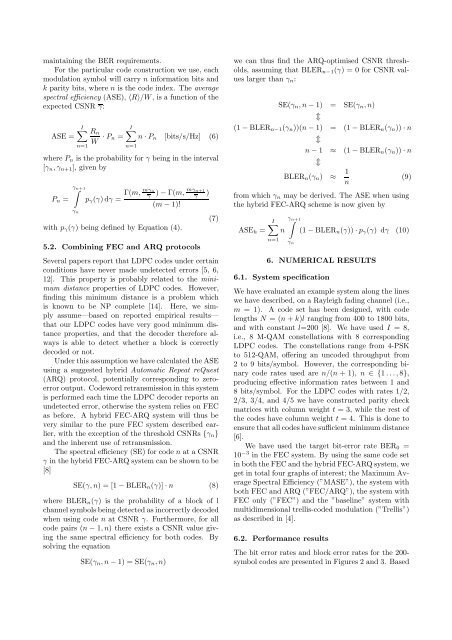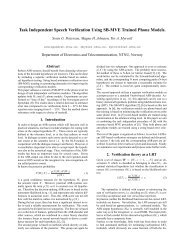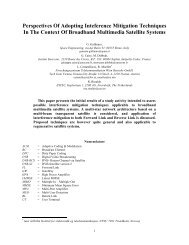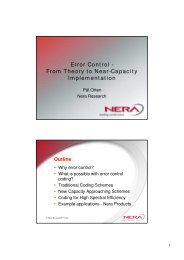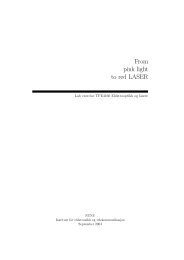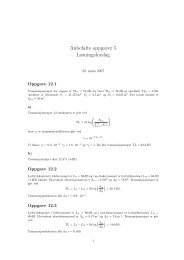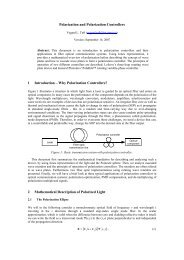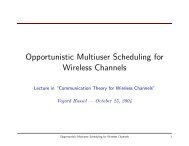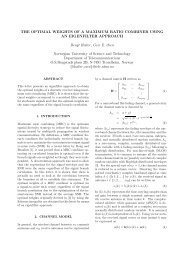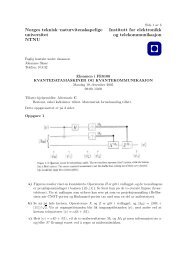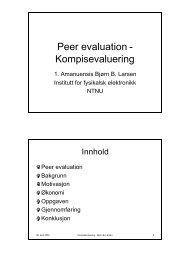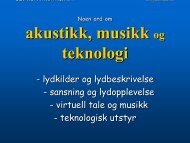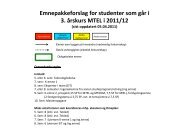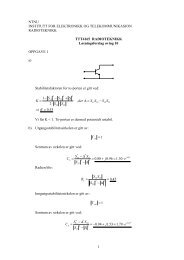LDPC CODED ADAPTIVE MULTILEVEL MODULATION ... - NTNU
LDPC CODED ADAPTIVE MULTILEVEL MODULATION ... - NTNU
LDPC CODED ADAPTIVE MULTILEVEL MODULATION ... - NTNU
Create successful ePaper yourself
Turn your PDF publications into a flip-book with our unique Google optimized e-Paper software.
maintaining the BER requirements.<br />
For the particular code construction we use, each<br />
modulation symbol will carry n information bits and<br />
k parity bits, where n isthecodeindex.Theaverage<br />
spectral efficiency (ASE), 〈R〉/W , is a function of the<br />
expected CSNR γ:<br />
ASE =<br />
I∑<br />
n=1<br />
R n<br />
W · P n =<br />
I∑<br />
n · P n [bits/s/Hz] (6)<br />
n=1<br />
where P n is the probability for γ being in the interval<br />
[γ n ,γ n+1 ], given by<br />
P n =<br />
∫<br />
γ n+1<br />
γ n<br />
p γ (γ)dγ =<br />
Γ(m,<br />
mγn<br />
γ<br />
) − Γ(m,<br />
mγn+1<br />
(m − 1)!<br />
with p γ (γ) being defined by Equation (4).<br />
5.2. Combining FEC and ARQ protocols<br />
γ<br />
)<br />
(7)<br />
Several papers report that <strong>LDPC</strong> codes under certain<br />
conditions have never made undetected errors [5, 6,<br />
12]. This property is probably related to the minimum<br />
distance properties of <strong>LDPC</strong> codes. However,<br />
finding this minimum distance is a problem which<br />
is known to be NP complete [14]. Here, we simply<br />
assume—based on reported empirical results—<br />
that our <strong>LDPC</strong> codes have very good minimum distance<br />
properties, and that the decoder therefore always<br />
is able to detect whether a block is correctly<br />
decoded or not.<br />
Under this assumption we have calculated the ASE<br />
using a suggested hybrid Automatic Repeat reQuest<br />
(ARQ) protocol, potentially corresponding to zeroerror<br />
output. Codeword retransmission in this system<br />
is performed each time the <strong>LDPC</strong> decoder reports an<br />
undetected error, otherwise the system relies on FEC<br />
as before. A hybrid FEC-ARQ system will thus be<br />
very similar to the pure FEC system described earlier,<br />
with the exception of the threshold CSNRs {γ n }<br />
and the inherent use of retransmission.<br />
The spectral efficiency (SE) for code n at a CSNR<br />
γ in the hybrid FEC-ARQ system can be shown to be<br />
[8]<br />
SE(γ,n)=[1− BLER n (γ)] · n (8)<br />
where BLER n (γ) is the probability of a block of l<br />
channel symbols being detected as incorrectly decoded<br />
when using code n at CSNR γ. Furthermore, for all<br />
code pairs (n − 1,n) there exists a CSNR value giving<br />
the same spectral efficiency for both codes. By<br />
solving the equation<br />
SE(γ n ,n− 1) = SE(γ n ,n)<br />
we can thus find the ARQ-optimised CSNR thresholds,<br />
assuming that BLER n−1 (γ) =0forCSNRvalues<br />
larger than γ n :<br />
SE(γ n ,n− 1) = SE(γ n ,n)<br />
⇕<br />
(1 − BLER n−1 (γ n ))(n − 1) = (1 − BLER n (γ n )) · n<br />
⇕<br />
n − 1 ≈ (1 − BLER n (γ n )) · n<br />
⇕<br />
BLER n (γ n ) ≈ 1 (9)<br />
n<br />
from which γ n may be derived. The ASE when using<br />
the hybrid FEC-ARQ scheme is now given by<br />
ASE h =<br />
I∑<br />
n<br />
n=1<br />
γ∫<br />
n+1<br />
γ n<br />
(1 − BLER n (γ)) · p γ (γ) dγ (10)<br />
6. NUMERICAL RESULTS<br />
6.1. System specification<br />
We have evaluated an example system along the lines<br />
we have described, on a Rayleigh fading channel (i.e.,<br />
m = 1). A code set has been designed, with code<br />
lengths N =(n + k)l ranging from 400 to 1800 bits,<br />
and with constant l=200 [8]. We have used I =8,<br />
i.e., 8 M-QAM constellations with 8 corresponding<br />
<strong>LDPC</strong> codes. The constellations range from 4-PSK<br />
to 512-QAM, offering an uncoded throughput from<br />
2 to 9 bits/symbol. However, the corresponding binary<br />
code rates used are n/(n +1), n ∈{1 ...,8},<br />
producing effective information rates between 1 and<br />
8 bits/symbol. For the <strong>LDPC</strong> codes with rates 1/2,<br />
2/3, 3/4, and 4/5 we have constructed parity check<br />
matrices with column weight t = 3, while the rest of<br />
the codes have column weight t =4. Thisisdoneto<br />
ensure that all codes have sufficient minimum distance<br />
[6].<br />
We have used the target bit-error rate BER 0 =<br />
10 −3 in the FEC system. By using the same code set<br />
in both the FEC and the hybrid FEC-ARQ system, we<br />
get in total four graphs of interest; the Maximum Average<br />
Spectral Efficiency (”MASE”), the system with<br />
both FEC and ARQ (”FEC/ARQ”), the system with<br />
FEC only (”FEC”) and the ”baseline” system with<br />
multidimensional trellis-coded modulation (”Trellis”)<br />
as described in [4].<br />
6.2. Performance results<br />
The bit error rates and block error rates for the 200-<br />
symbol codes are presented in Figures 2 and 3. Based


